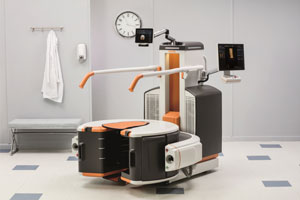Growing Number of Hospitals, Orthopaedic Practices Install Carestream OnSight 3D Extremity Imaging Systems
ROCHESTER, N.Y., Nov. 8 — Hospitals, orthopaedic practices and other imaging services providers in the United States, Europe and other countries are adopting CARESTREAM OnSight 3D Extremity Systems (video). These systems deliver high-resolution 3D images with advanced anatomical detail that can help orthopaedic specialists make more accurate diagnostic and treatment decisions. The imaging system will be displayed at the Radiological Society of North America annual conference (Booth #4705).
 Twin Cities Orthopedics (Golden Valley, Minn.) has installed OnSight 3D Extremity systems in the practice’s Woodbury, Minn., and Eagan, Minn., locations.
Twin Cities Orthopedics (Golden Valley, Minn.) has installed OnSight 3D Extremity systems in the practice’s Woodbury, Minn., and Eagan, Minn., locations.
“Carestream’s advanced imaging systems offer a larger field of view and better image quality than many other systems. Many types of injuries and conditions can now be viewed in greater detail, which can enhance diagnostic decision-making and help patients heal faster,” said Eric Christensen, Director of Imaging for Twin Cities Orthopedics.
“Our orthopaedic specialists report that more detailed images help them better detect scaphoid fractures and the extent of healing after subtalar fusions as well as comminuted fractures of hands, wrists, elbows, knees, ankles and feet,” said Mr. Christensen. “We are also using it to create 3D reformats to better aid orthopaedic surgeons in surgical planning. We are removing bones adjacent to fractures in order to better understand articulations that previously couldn’t be seen. It’s been an excellent investment for our practice and our patients.”
Carestream’s OnSight 3D Extremity system uses a large-area detector that captures a 3D extremity image in a single rotation that takes only 25 seconds. Optional enhanced metal artifact reduction software can improve visibility of anatomy around metallic objects. The latest version of Carestream’s image viewing software is designed to increase workflow efficiency, enhance volumetric post-processing compatibility with PACS, fulfill NEMA XR-29 standards compliance and offer new features for users in hospitals, imaging centers and orthopaedic clinics. This software is free of charge for current customers and will be installed on new OnSight 3D Extremity systems.
“Our second generation of CMAR 2 metal artifact reduction software can improve visibility of patient anatomy near metallic objects and reduce the halo effect and other artifacts that may appear in the image. This helps orthopaedic specialists optimize their diagnostic and treatment decisions,” said Helen Titus, Carestream’s Business Segment Manager, Cone Beam CT.
The software makes it easier to view metal screws, plates, nails and other hardware. Both the original image and corrected image are always available to view and compare. A user selects a moderate or complex metal setting so Carestream’s image processing software can deliver an optimized view based on metal content. Metal artifact reduction can be activated prior to the scan or after the original reconstruction is complete.
Dose is significantly reduced because only the affected body part is imaged. And since the patient’s head and body are not confined, patients do not experience the claustrophobia that often occurs with traditional CT systems. The compact extremity system can be installed in an exam room and plugs into a standard wall outlet. The Carestream OnSight 3D Extremity system is available in the United States, Europe and other countries.
###
About Twin Cities Orthopedics
For more than 75 years, Twin Cities Orthopedics has proudly provided a full spectrum of orthopedic and sports medicine care, devoted to the diagnosis, treatment, rehabilitation and prevention of injuries and conditions that affect the body's muscles, joints and bones. TCO’s 115 physicians provide superior quality care across 39 state-of-the-art facilities in the Twin Cities and western Wisconsin. Visit www.TCOmn.com to learn more.